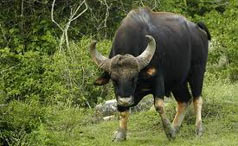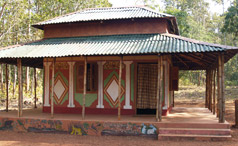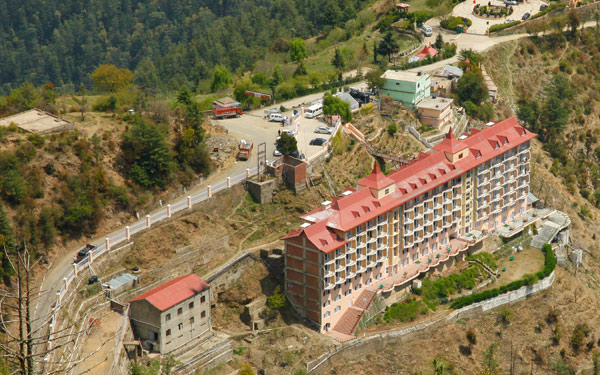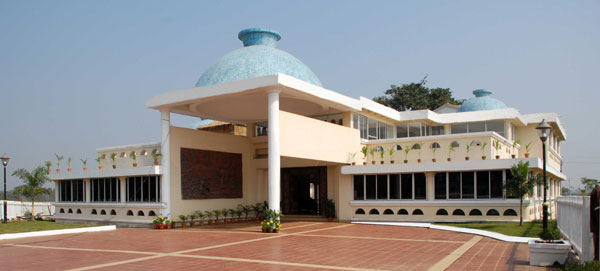Simlipal National Park
FACTS & FIGURES
| Area |
2,750 sq km (gross area) |
| Language |
Oriya, English |
| Best time to visit |
October to mid-June |
INTRODUCTION

Simlipal national park originated primarily as a hunting ground for the royalty. It was formally designated a tiger reserve in 1956 under Project Tiger in May 1972. It was elevated to a national park status in 1979. Located in the Mayurbhanj district of India's coastal state of Orissa, Simlipal is an ecosystem complete with forest vegetation (mainly sal trees), fauna and the adjoining Santhal tribal settlements. High plateaus and hills, the highest peak being the Mangesheri, surround the forest. At least 12 rivers cut across the plain area. The prominent among them are Burhabalanga, Palpala Bandan, Kahairi and Deo. This sprawling forest also has many waterfalls that are a perpetual attraction to the tourist. It has withstood two cyclones-in 1982 and 1999-without any irrevocable damages and continues to enchant visitors.
BEST TIME TO VISIT
During summers, the temperature is very high (around 40°C) whereas during the winter it falls to about 14°C. The monsoon season brings moderate to very heavy rainfall.
TOURISTS ATTRACTIONS
This sprawling ecosystem, thanks to the mega conservation efforts, has close to a 100 tigers. Other mammalian species like leopards, sambhars, langurs, deer, gaur (Indian bison), elephants, antelopes, chitals, chevrotains, wild dog, wild boar, sloth bears, monkeys, hyenas and porcupines are also found here. There are around 230 species of birds in these forests. The ones officially recorded include the red jungle fowl, hill myna, peafowl, alexandrine parakeet, crested serpent eagle, gray hornbill, Indian pied hornbill, Malabar pied hornbill and Indian trogon. Most of these bird species may be spotted in the park's Newana area. There is a sizable population of reptiles as well, which include snakes and turtles. The population of crocodiles has increased considerably since the inception of the Mugger Management Program.

Simlipal National Park is a floral treasure as well. It has close to 501 species of plants belonging to 102 families. Eighty-two species of orchids have already been identified here along with the omnipresent sal trees. Innumerable medicinal and aromatic plants are found as well that are a source of earnings for the local tribal population.
A panoramic view of the park can be enjoyed from Barheipani (1308 ft.) region. The most beautiful and scenic waterfalls of the park are found here and at Joranda (493 ft.).
PLACES AROUND SIMLIPAL NATIONAL PARK
Excursions from Simlipal National Park include the temple town of Bhubaneshwar and the former colonial capital of British India, Calcutta. Both destinations have direct air, rail and road links.
HOW TO REACH
Reaching Simlipal National Park is very easy. There are three major airports and rail junctions in the vicinity. These include Jamshedpur (140 km), Bhubaneswar (320 km) and Calcutta (240 km). Road network and highway links in the area are quite efficient.
WHERE TO STAY
Toshali Jungle Lodge, Simlipal
 Orissa's Beautiful Jungle Retreat
Orissa's Beautiful Jungle Retreat
Straddling 2750 sq. km of the Chotanagpur Plateau in Mayurbhanj district, Orissa, the Simlipal Bisophere Reserve-which's a part of the Mahanandian Biogeographical region-- is a uniqueunique, untainted preserve of a wide range of flora and fauna. Since 1973, it has been one of the 14 biosphere reserves of India, also shouldering the responsibility of creating a safe habitat for the tiger under the Project Tiger programme.
The 888 sq. km of the Tiger reserve Reserve forest is designated as the core, and is supported by an 1862 sq. km buffer zone. Seven rivers and their tributaries flow through the jungles of the reserve which is rich with Simul (Silk Cotton trees). These trees, laden with red flowers, look wonderful as if straight out of beautiful picture cards.
The scenic Jornada and Barehipani waterfalls inside the reserve are the famous landmarks of the place and much add to the appeal of Simlipal. The Kiriburu and Methasani Mountain peaks rise from the jungles of Simplipal inviting the visitors to scale it to have a good look of the scenic reserve. Tribals reside in the four villages within the core of the park, while 58 villages are scattered on the periphery.
Visitors to Simlipal are rewarded with a 'real' and unadulterated feel of a forest, and the park is ideal for serious bird watchers and botanists. The Biosphere Reserve supports 1076 species of flora and fairly large numbers of leopards, gaur, elephants, barking deer, sloth bears, mongoose, porcupines and flying squirrels. Watch out for the many slithery reptilian species also as the Simlipal Biosphere Reserve boasts of many of them.
 Simlipal national park originated primarily as a hunting ground for the royalty. It was formally designated a tiger reserve in 1956 under Project Tiger in May 1972. It was elevated to a national park status in 1979. Located in the Mayurbhanj district of India's coastal state of Orissa, Simlipal is an ecosystem complete with forest vegetation (mainly sal trees), fauna and the adjoining Santhal tribal settlements. High plateaus and hills, the highest peak being the Mangesheri, surround the forest. At least 12 rivers cut across the plain area. The prominent among them are Burhabalanga, Palpala Bandan, Kahairi and Deo. This sprawling forest also has many waterfalls that are a perpetual attraction to the tourist. It has withstood two cyclones-in 1982 and 1999-without any irrevocable damages and continues to enchant visitors.
Simlipal national park originated primarily as a hunting ground for the royalty. It was formally designated a tiger reserve in 1956 under Project Tiger in May 1972. It was elevated to a national park status in 1979. Located in the Mayurbhanj district of India's coastal state of Orissa, Simlipal is an ecosystem complete with forest vegetation (mainly sal trees), fauna and the adjoining Santhal tribal settlements. High plateaus and hills, the highest peak being the Mangesheri, surround the forest. At least 12 rivers cut across the plain area. The prominent among them are Burhabalanga, Palpala Bandan, Kahairi and Deo. This sprawling forest also has many waterfalls that are a perpetual attraction to the tourist. It has withstood two cyclones-in 1982 and 1999-without any irrevocable damages and continues to enchant visitors.  Simlipal National Park is a floral treasure as well. It has close to 501 species of plants belonging to 102 families. Eighty-two species of orchids have already been identified here along with the omnipresent sal trees. Innumerable medicinal and aromatic plants are found as well that are a source of earnings for the local tribal population.
Simlipal National Park is a floral treasure as well. It has close to 501 species of plants belonging to 102 families. Eighty-two species of orchids have already been identified here along with the omnipresent sal trees. Innumerable medicinal and aromatic plants are found as well that are a source of earnings for the local tribal population.  Orissa's Beautiful Jungle Retreat
Orissa's Beautiful Jungle Retreat







